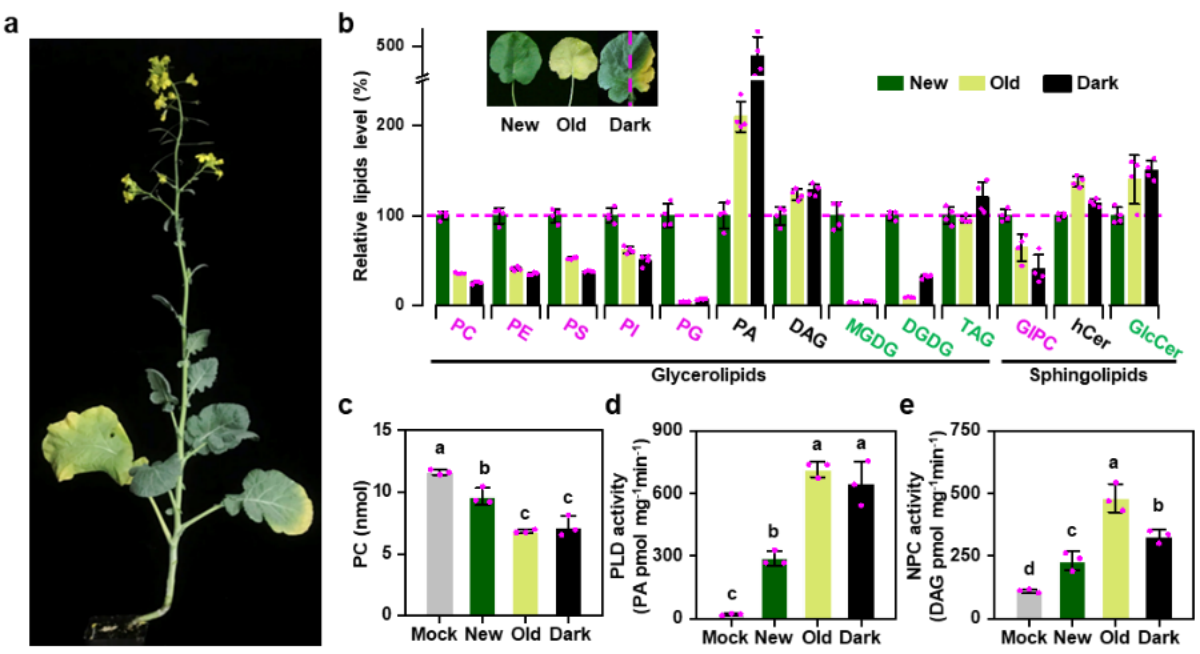南湖新闻网讯(通讯员 杨报)磷是植物生长所必需的大量元素,是细胞内生物大分子(蛋白质、核酸等)和代谢小分子(磷脂、三磷酸腺苷等)的重要组分。磷脂是植物细胞磷素的重要存储库之一,膜磷脂中储存的磷(脂质磷)占细胞总磷的1/3至1/2。叶片是植物最大的营养器官之一,叶片在衰老过程中会将细胞中的各种营养元素如碳、氮、磷和钾等转移到新的组织中,进而提高营养元素的利用效率。叶片细胞中含有丰富的脂质磷,衰老叶片中超过90%的磷素可以被转运到新组织中,但脂质磷回收再利用的途径和机制还鲜有报道。
近日, Genome Biology以“Phospholipase-mediated phosphate recycling during plant leaf senescence”为题在线发表了我校油菜团队最新研究成果。该研究中发现油菜等植物叶片衰老过程中由磷脂酶介导的膜磷脂水解是植物细胞磷回收的关键途径之一。衰老诱导表达的非特异性磷脂酶C4 (Nonspecific phospholipase C4, NPC4)和磷脂酶Dζ2 (phospholipase Dζ2,PLDζ2)是介导这一代谢过程的关键磷脂酶。

图1. 油菜叶片衰老过程中膜磷脂被大量降解
叶片衰老过程中,超过90%的磷会从衰老的叶片中回收。油菜叶片衰老过程中磷脂酶PLD和PLC活性被高度诱导。分析油菜叶片发育时间序列转录组,发现叶片衰老相关基因与植物缺磷响应和脂质代谢相关基因高度共表达。进一步分析植物磷脂代谢相关基因表达谱,发现油菜叶片衰老过程中磷脂酶基因NPC4和PLDζ2被显著诱导表达,同时油菜发育各组织各时期表达谱中这两类磷脂酶基因主要在衰老组织中高表达,它们的表达模式与植物叶片衰老、响应ABA、响应缺磷胁迫和脂质代谢相关基因高度相似。
进一步通过基因功能验证,发现NPC4和PLDζ2在油菜叶片衰老过程中发挥着关键作用。NPC4和PLDζ2的敲除突变体会延缓膜磷脂的降解,并延迟油菜叶片的衰老。相反,NPC4和PLDζ2过表达会加速膜磷脂的降解和叶片衰老,促进脂质磷从衰老叶片中再回收到幼嫩组织中,进而提高磷素利用效率促进植物的生长。同事,大豆、玉米、棉花等10种植物衰老叶片中磷和磷脂含量、磷脂酶基因表达分析结果表明,叶片衰老过程中由膜磷脂水解介导的磷回收过程在植物中是保守的。该研究指出NPC4和PLDζ2介导的膜磷脂水解促进了脂质磷从衰老叶片到幼嫩叶片中的再利用,并且磷脂水解介导的磷素回收利用提高了作物的磷素利用效率。

图2. 油菜叶片衰老过程中磷脂酶介导的磷素回收模型
华中农业大学、美国密苏里大学圣路易斯分校、唐纳德丹佛斯植物科学中心博士后杨报为本文的第一作者,崖州湾国家实验室博士后谭增栋对转录组和脂质组数据进行了分析,美国密苏里大学圣路易斯分校、唐纳德丹佛斯植物科学中心王学敏教授对论文修改提供了宝贵意见,我校郭亮教授和鲁少平副研究员为共同通讯作者。
【英文摘要】
Background
Phosphorus is a macronutrient necessary for plant growth and development and its availability and efficient use affect crop yields. Leaves are the largest tissue that uses phosphorus in plants, and membrane phospholipids are the main source of cellular phosphorus usage.
Results
Here we identify a key process for plant cellular phosphorus recycling mediated by membrane phospholipid hydrolysis during leaf senescence. Our results indicate that over 90% of lipid phosphorus, accounting for more than one-third of total cellular phosphorus, is recycled from senescent leaves before falling off the plants. Nonspecific phospholipase C4 (NPC4) and phospholipase Dζ2 (PLDζ2) are highly induced during leaf senescence, and knockouts of PLDζ2 and NPC4 decrease the loss of membrane phospholipids and delay leaf senescence. Conversely, overexpression of PLDζ2 and NPC4 accelerates the loss of phospholipids and leaf senescence, promoting phosphorus remobilization from senescent leaves to young tissues and plant growth. We also show that this phosphorus recycling process in senescent leaves mediated by membrane phospholipid hydrolysis is conserved in plants.
Conclusions
These results indicate that PLDζ2- and NPC4-mediated membrane phospholipid hydrolysis promotes phosphorus remobilization from senescent leaves to growing tissues and that the phospholipid hydrolysis-mediated phosphorus recycling improves phosphorus use efficiency in plants.
论文链接:https://genomebiology.biomedcentral.com/articles/10.1186/s13059-024-03348-x
审核人:鲁少平